Lucky enough to get myoga (Japanese ginger) this season? Make this easy Myoga Amazuzuke pickled in a classic sweet brine of rice vinegar, sugar, and salt. Sweet pickled Japanese ginger is so refreshing and addicting, and it‘s our favorite summertime pickle.
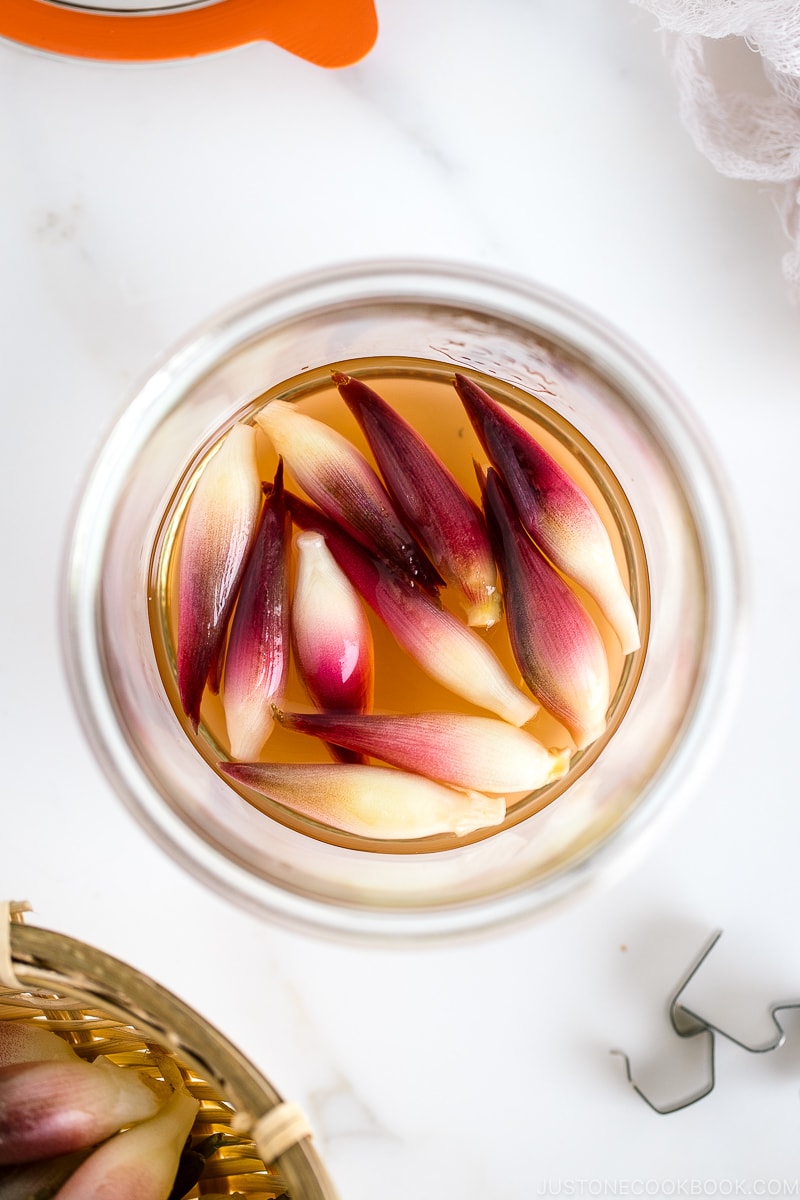
I received homegrown myoga as a gift from a local JOC reader and have enjoyed making all kinds of myoga recipes. This one for Myoga Amazuzuke (みょうが甘酢漬け), or Sweet Pickled Japanese Ginger, is my particular favorite. It’s my family’s most-loved pickle in the summertime! It’s tasty on its own, and it also makes a lovely accompaniment to jazz up our salads and rice.
Table of Contents
What Is Myoga (Japanese Ginger)?
Myoga (ミョウガ, みょうが, 茗荷) is the species Zingiber mioga in the Zingiberaceae family. Native to Japan, China, and Korea, myoga is harvested for its unopened flower bud and flavorful shoot instead of its root. The flower buds are slightly larger than thumb-size and have pinkish bronze outer layers.
It is sometimes called myoga ginger or Japanese ginger. You can read more about it on my myoga pantry page.
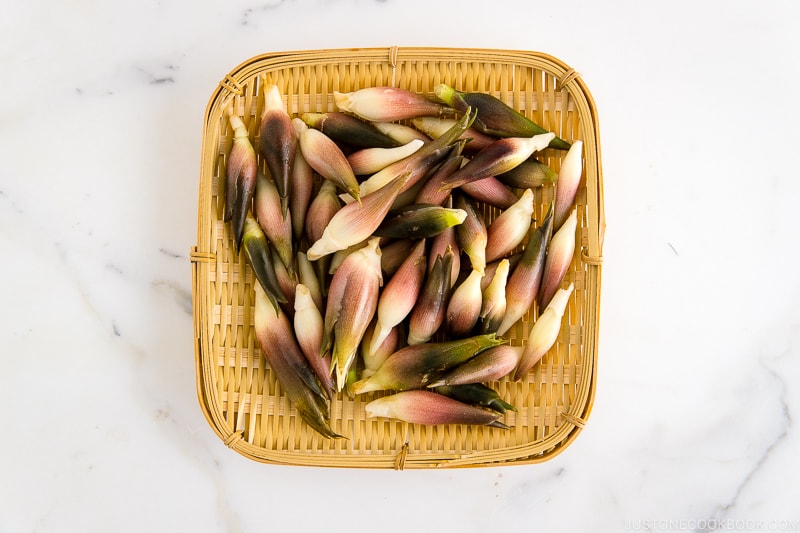
What is Amazuzuke?
Amazuzuke (甘酢漬け) is a Japanese technique of pickling fresh vegetables in sweet vinegar. The name refers to the sugar and rice vinegar (amazu) solution used for pickling (zuke). It is one of the very basic Japanese pickles known collectively as tsukemono (漬物). You might be familiar already with the most well-known example of an amazuzuke—pickled sushi ginger or gari (ガリ).
If you’re interested in learning more about different types of tsukemono, read my post Tsukemono: A Guide to Japanese Pickles.
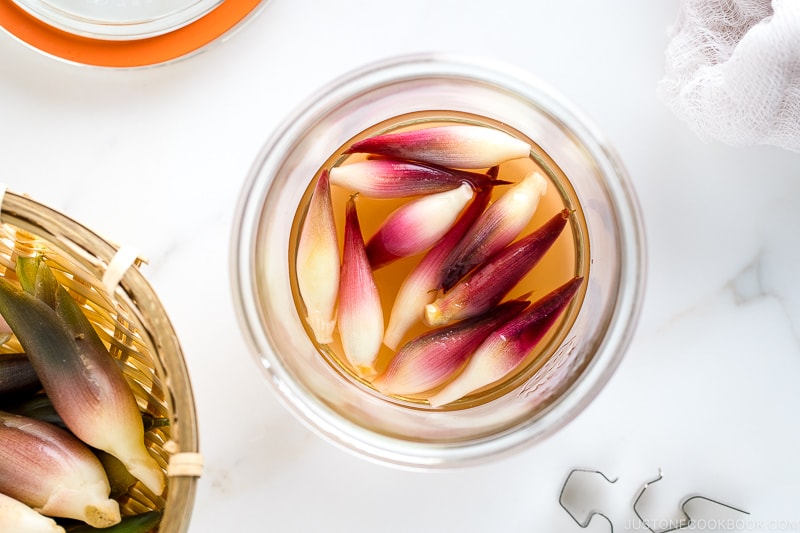
Ingredients You’ll Need
The sweet pickling solution is made with 4 simple ingredients:
- rice vinegar — it has a mild, tangy taste compared to other types of vinegar
- sugar — adjust the amount as you like; store-bought tends to be sweeter
- kosher salt
- myoga (Japanese ginger)
Substitutions and Variations
Can’t get myoga? Try using other vegetables! First slice the vegetables and sprinkle salt over them to draw moisture out before pickling. After 10–15 minutes, squeeze to remove the moisture. Then, pickle in the solution. See the list below for other vegetables to try:
- carrot
- cabbage
- cucumber
- daikon radish
- kabu (Japanese turnip)
- renkon (lotus root)
- red onion
- yellow/red/orange bell pepper
How to Make Sweet Pickles (Amazuzuke)
- Make the sweet pickling solution. Combine rice vinegar, sugar, and salt in a pot. Bring to a boil.
- Pour the hot solution over the myoga or fresh produce of your choice in a jar.
- Pickle for 2 days. The pickles can last up to 2 weeks in the fridge.
That’s it! Easy, right? The pickled myoga will turn a beautiful pink color after a few days.
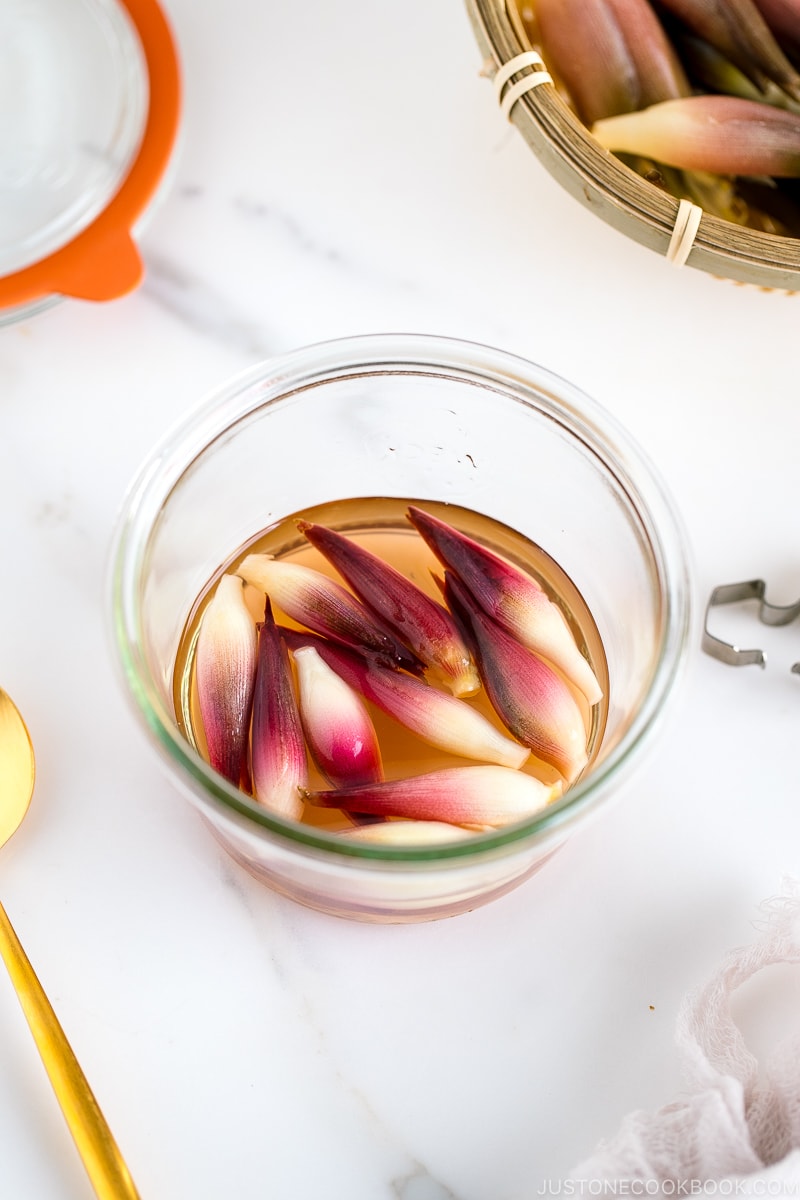
How to Enjoy Myoga Amazuzuke
Tangy and refreshing, this sweet pickled Japanese ginger is so versatile. Enjoy it whole or sliced with:
- BBQ spreads
- cold summer noodles like somen
- grilled seafood or meat
- salads, lettuce wraps, or rice
- Japanese-inspired sandwiches (I haven’t tried it, but I think it would taste delicious! Let me know in the comments if you try this!)
Other Myoga Recipes You’ll Love
Love myoga ginger? Try these varieties of myoga recipes:
- Mizuna Myoga Salad with Ponzu Sesame Dressing
- Pickled Cucumbers and Myoga
- Myoga Shiso Rice
- Eggplant and Myoga Salad
- Tomato Myoga Salad
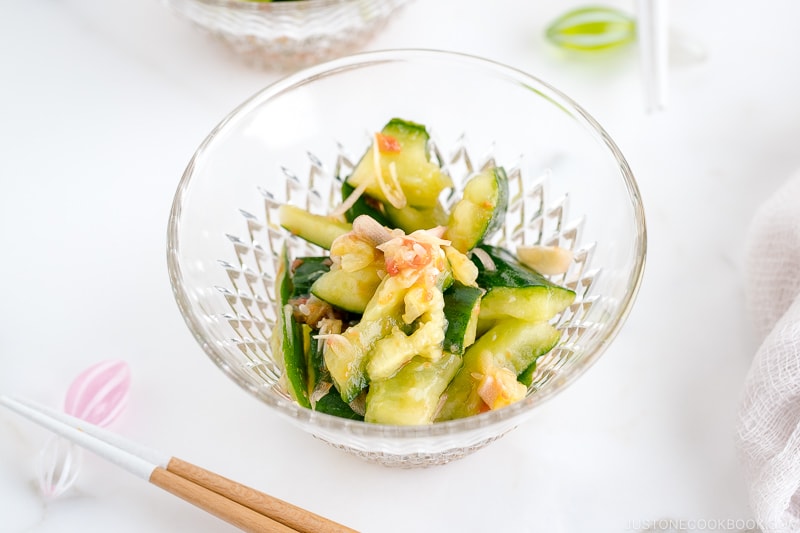
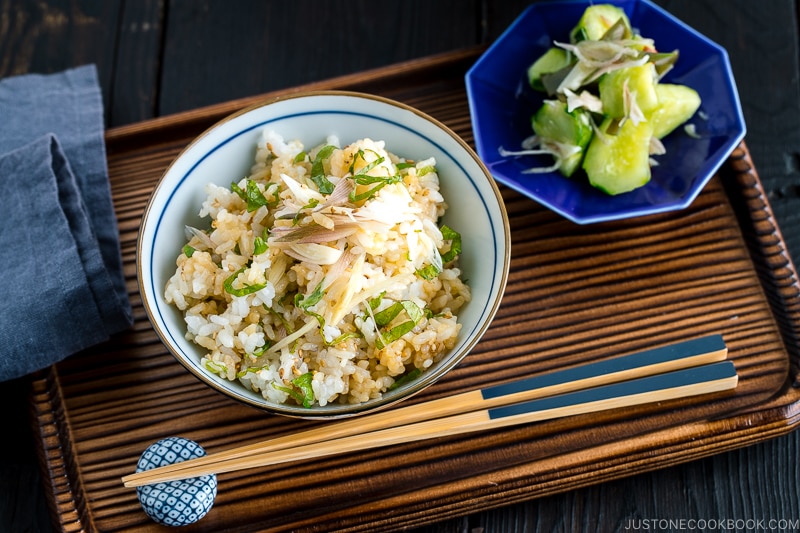
Wish to learn more about Japanese cooking? Sign up for our free newsletter to receive cooking tips & recipe updates! And stay in touch with me on Facebook, Pinterest, YouTube, and Instagram.
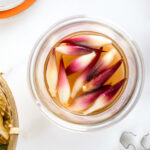
Sweet Pickled Japanese Ginger (Myoga Amazuzuke)
Ingredients
- 10 myoga ginger (1.8 oz, 50 g; you can add more as long as they are covered by the pickling solution; read more about substitutions in the blog post)
For the Amazu (Sweet Pickling Solution)
- ¼ cup rice vinegar (unseasoned)
- 2½ Tbsp sugar
- ½ tsp Diamond Crystal kosher salt
Instructions
- Before You Start…Please note that this recipe requires 2+ hours of pickling time.Gather all the ingredients. Rinse and cut off the ends of 10 myoga ginger.
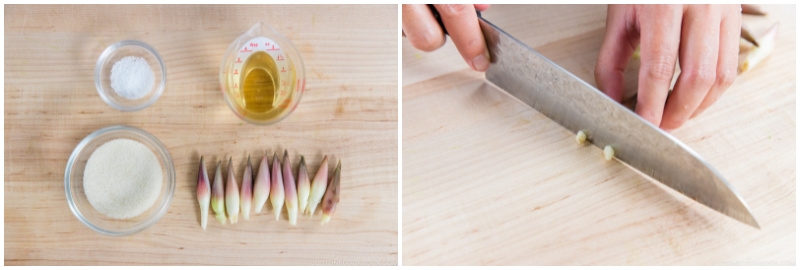
- Make the amazu. In a small saucepan, combine ¼ cup rice vinegar (unseasoned), 2½ Tbsp sugar, and ½ tsp Diamond Crystal kosher salt.
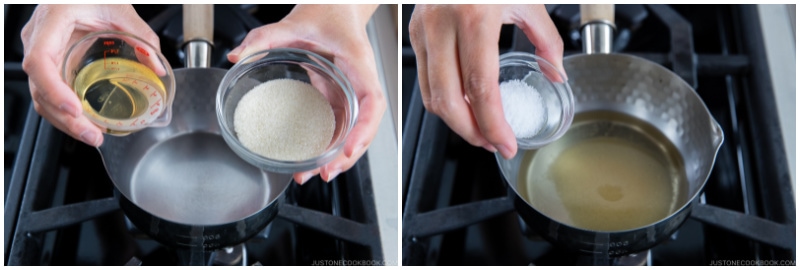
- Bring it to a boil over medium heat and let the sugar dissolve completely.
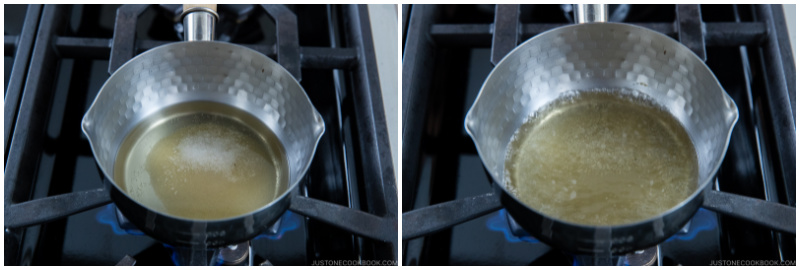
- Add the myoga to an airtight jar and pour the hot amazu over it. Once cooled, cover and refrigerate it for at least 2 days.

- After two or three days, the myoga ginger will now have a beautiful color. Serve it as an accompaniment to brighten up your meals. See more serving ideas in the blog post.
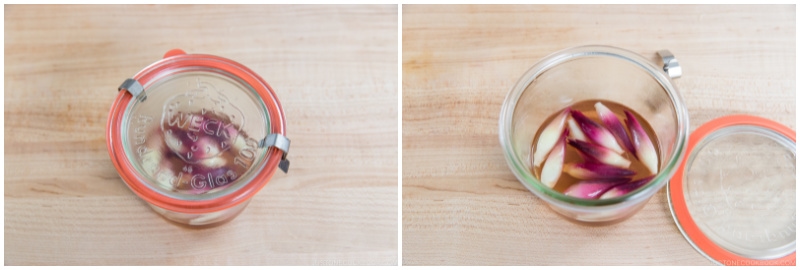
To Store
- Keep it in the airtight container and store in the refrigerator for up to 2 weeks.
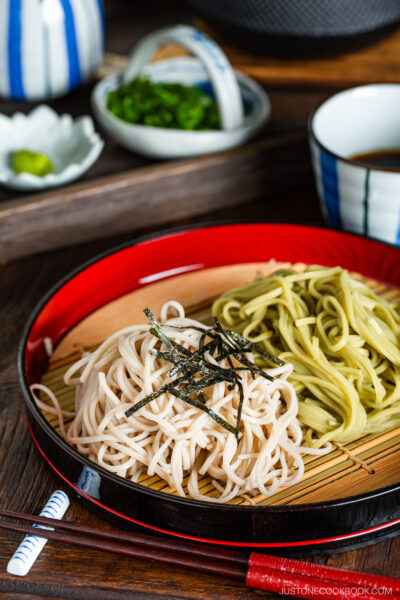
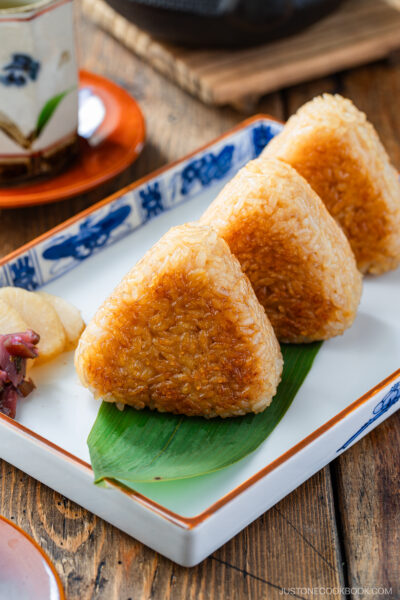
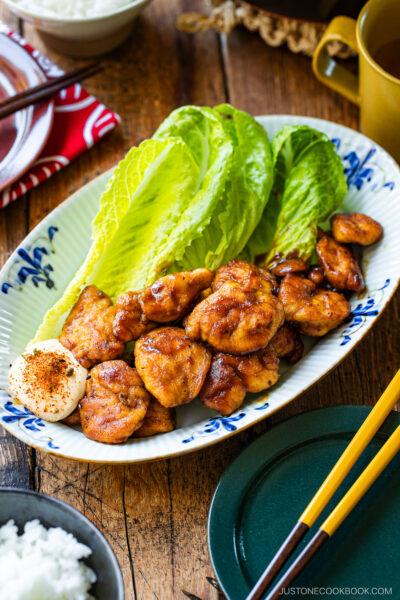
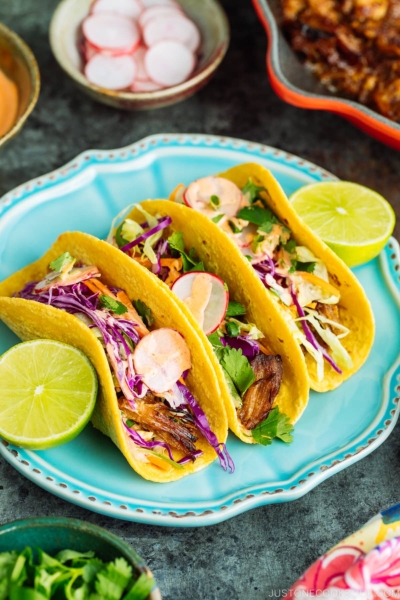




Hi
I also wonder how the myoga can be preserved for longer orher than freezing.
I have a very large patch in my garden ( in New Zealand) and wondered if the myoga was cooked in the pickling liquid for say 5 mins and then packed into hot jars, covered in liquid and then sealed until the lids popped down would work. It does for ‘bread and butter pickles’ and lengthens the storage time considerably.
Hello Liz, Thank you for reading Nami’s post.
Your method would work, but we keep the jars in the refrigerator. If you do not open the jar, it will last approximately 6 months. Once opened, store the jar in the refrigerator and use it as soon as possible. We hope this works for you too.
Hello, im wondering if there are any safe canning recipes for myoga? refrigerator pickles are great but I have a larger harvest and was wondering if it was possible.
Hello, Trevor. Thank you for visiting our site!
We don’t have any canning recipes for Myoga, but what about freezing it? Clean it first, then pad-dry it with paper towels and wrap it in plastic wrap. Then place them in the zip-top bag. They can also be frozen after being sliced. We hope this was helpful!
Hi – i am growing myoga for first time – I am in Canberra Australia. I decided to grow it because I wanted to have it pickled with sashimi but now I am not sure that is actually how Japanese eat it? Can you shed any light? Katy
Hi Kathry! Wow! Homegrown Myoga must be delicious!
Please check out this post again and scroll down to “How to Enjoy Myoga Amazuzuke”. Nami explained there and also shared the Myoga recipes.
https://www.justonecookbook.com/myoga-amazuzuke/
And here is another post about Myoga.
https://www.justonecookbook.com/myoga/
We hope this helps!
Hi, Namiko.
I found some myoga today and some yuzu fruit. Happy Day! My Asian store stocks specialty items only when available and usually in smaller quantities. If I were to go the store daily, I would probably come home with great finds (including fresh fish) but with a much reduced bank account! Lol! I live only 5 minutes away so it’s feasible but not practical.
So, I came home so excited with my myoga find. I then realized I had some ginger in the crisper that was getting past its prime and had made a mental note to pickle it. So I took it out, cut off all the bad pieces, made sure I sniffed each piece and removed anything that smelled off, sliced, and now it’s lacto-fermenting. I prefer doing it that way instead of using vinegar. My mother (born 1934) told me that BITD that’s how it was done, like making umeboshi…no vinegar. But, if you have time and I wished I would have taken photographs about how to make sure one’s ginger is fresh, a brief tutorial would be helpful for a lot people. I just do it out of habit. You don’t have to see obvious mold if parts of the ginger are going bad. For me, it’s “use your nose!” There’s a certain color that develops, a darker yellow that is indicative of the ginger turning. It will ruin the flavor of whatever you’re making. A lot of people just buy any old ginger at the grocery store with no clue if it’s fresh or not. I was at a store and gave a woman a quick tutorial since she was buying it fresh for the first time to make a tea and had no clue which piece of ginger to select. I hope she listened. For me, when I hear that ginger tastes earthy that means it isn’t fresh.
Anyway, back to myoga. I think I will pickle it like my ginger, lacto-fermented. Looking forward to it.
Btw…did I mention how to make ume-su with store-bought plums? Again, no vinegar and it takes just like the brine from umeboshi which I have made many times. That’ll have to be a different comment. Hehe.
As always, THANKS!
~Chieko
Hi Chieko! What an exciting day you had! Thank you for reading Nami’s post and taking the time to share your story with us!
We are happy to hear that you found Myoga and Yuzu in a local store!
We would like to share our Myoga and Ginger posts with you. We hope you find this helpful.🙂
https://www.justonecookbook.com/myoga/
https://www.justonecookbook.com/young-ginger/
I have a patch of myoga ginger and have never harvested it because I didn’t really know when. I just found the flowers the other day hiding under a bunch of hostas. I think the flowers are too old to harvest. What do you think?
Hi Deni, Thank you very much for sharing your photo!
The Myoga looks still good to enjoy it! We recommend harvest now and try picking them.
Next year, try harvesting a little sooner.🙂
We hope this helps!
Does regular ginger work with this recipe?
Hi Tina, Sure, you can use regular ginger or try the Gari – Pickled Sushi Ginger recipe.
It is a very similar recipe to this recipe with sliced ginger. https://www.justonecookbook.com/pickled-ginger/
We hope this helps!